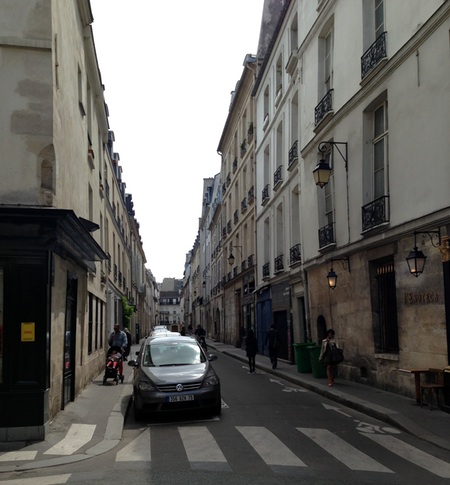Braden Perkins and Laura Adrian started out in Seattle. For several years, they ran an underground dining club in Paris, Hidden Kitchen, which became a bit of a legend. I even had a reservation once, but the underlying trip, alas, fell through. Now they have a restaurant, Verjus, where they serve a fixed (but ever-changing) tasting menu. Here was ours:
What is this saying? I think it says a lot.
First, it tastes good! It’s reasonably balanced and reasonably healthy. It concentrates on things that it makes sense to eat at a restaurant, even if you cook, because they depend on lots of time-consuming products or require ingredients you don’t have. Tonka beans, for example, are banned in the US, and Madame Hisada is a long trek from Boston.
Second, this is a wildly untraditional format. The ancient ancestor of the restaurant, the table d’hôte, did have a fixed menu: you came and ate what they made there. If you wanted roast chicken, you went to the fellow who roasted chicken and not to the fellow who stewed lamb. The other tradition grew out of health food and is what we call a restaurant: it had a list of broths and foods and potions and would fix up whatever your doctor ordered. But the restaurant menu settled down to an entrée, a plat, and a dessert, with maybe an apéro first and some mignardises later. In Italy, you’d add a pasta course, and in England you might have a fish course.
But all these small courses are something new here; Alexander Lobrano calls it a public dinner party. It’s been controversial. And it returns, I think, to a very old discussion that Paris has had with America, the Ben Franklin admiration of gentle rusticity, of the new world’s projection of informality into ritual and thereby to get back to the heart of the thing. Simple, comfortable tables and simple, comfortable service are the modern translation of Franklin’s well-tailored homespun suits. The food matters and that’s why we’re all here, so let’s not stand on ceremony.
There are allusions in the food as well. I’m missing lots of them, I’m sure, but composing the menu as a list of ingredients can only be a nod to Alinea. I don’t know what a banka trout looks like when it’s at home, but if you Google it you’ll find that the top hits all go to Frenchie, George Marchand’s famous foodie destination of this Parisian moment.
In Back Of The House
, Scott Haas makes an interesting point about chef Tony Maws (Craigie on Main). Lots of American celebrity chefs were raised to consider themselves poor, and until very recently all traditionally-trained cooks in France were working class men. Maws grew up in upper-middle-class Boston; his family eats at Craigie because it’s the sort of place they’ve always gone. That changes and defuses a lot of the class tension that underlies restaurant ritual.
Yesterday’s restauranteur was a servant, though perhaps one with valued expertise. California service reminds us that this is just a convention. “I’ll be your server tonight†acknowledges that tomorrow, you may be my server. For Brecht/Weil, that transition required a black freighter mit fünfzig Kanonen. Here, now, it’s every day.
There’s more to work through here, I think, and a lot that I’m missing. That’s OK, too: we don’t need to understand every element in the meal or follow every argument. But this is a meal with something to say. Not whispered but not shouted, it stands up and speaks out.
